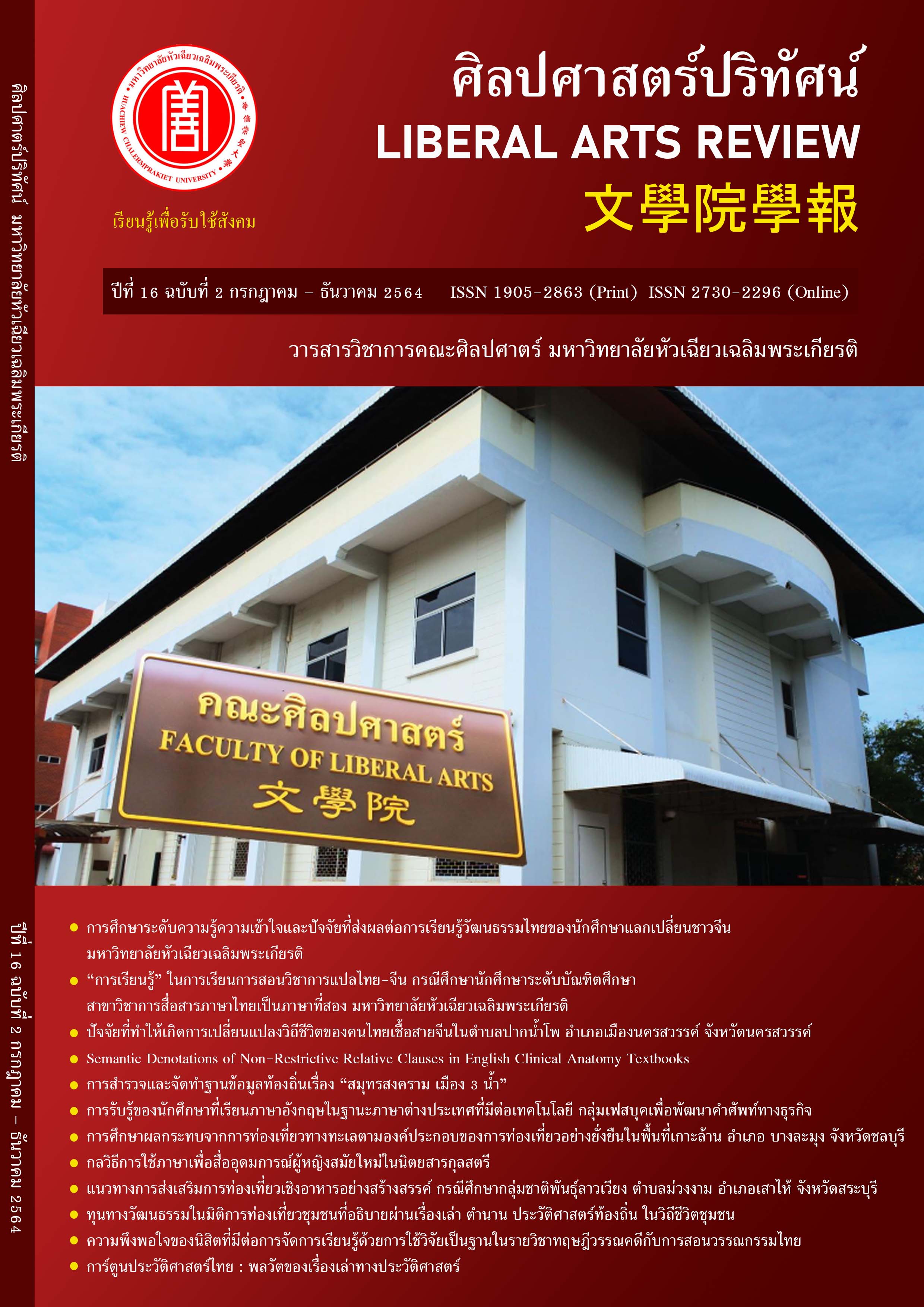Semantic Denotations of Non-Restrictive Relative Clauses in English Clinical Anatomy Textbooks
Keywords:
Semantic denotations, Non-restrictiverelative clauses(NRRCs), Englishclinical anatomy textbooksAbstract
This study investigated the semantic denotations of non-restrictive relative clauses (NRRCs) in English clinical anatomy textbooks. While previous studies focused on NRRCs in different text varieties (i.e., novels, international corpus), this study fills the gap by contributing something new to the field by studying NRRCs in English clinical anatomy textbooks. The materials were collected from Netter’s Clinical Anatomy (2019) and Gray’s Anatomy for Students (2020). Not only are they best-selling textbooks (amazon.com), but the writers of these textbooks are also professionally qualified concerning their educational qualifications and clinical work experience. Approximately 268,600 words, containing 184 tokens of NRRCs, were extracted from these textbooks. NRRCs were analyzed via the keywords of wh-relativizer who, whom, whose and which used with comma(s). The results showed that 98.91 percent of NRRCs in the English clinical anatomy textbooks occurred with the relativizer which. The semantic denotations of NRRCs in English clinical anatomy are components, formation and liquid movement at nearly 60 percent. The use of NRRCs in English anatomy textbooks allows us to see different semantic denotations, specifically used with this syntactic structure. It is hoped that the results of this study will be beneficial to the field of medical English. Moreover, it would be helpful for learners of English as a foreign language.
References
Abdolmanafi, S. & Rahmani Z. (2012). An investigation of the learnability of relative clauses by EFL learners. World Journal of English Language, 2(3), 29-37.
Adika, G. S. K., & Klu, E. K. (2014). A study of the relative clause as a modifier in two Ghanaian newspapers. Mediterranean Journal of Social Sciences, 5(20), 2943.
Arimura, K. (2010). Non-restrictive relative clauses and force. The Journal of Konan University, 160, 113-112.
Arnold, D. (2005). Restrictive relatives are not orphans. Journal of Linguistics, 271-309.
Allen, D. (2009). A study of the role of relative clauses in the simplification of news texts for learners of English. System, 37, 585-599.
Baker, C. (2002). Continuation and the nature of quantification. Natural Language Semantics. 10(3), 211-242.
Collins, P., Yao, X., & Borlongan, A. (2014). Relative clauses in Philippine English: A diachronic perspective. In Recent Advances in Corpus Linguistics (pp. 123-146). Brill Rodopi.
Drake R. A, Vogl, W. &, Mitchell, A. (2020). Gray’s anatomy for students. USA: Elsevier.
Gilquin, G., & Jacob, G. (2006). Elephants (who) marry mice are very unusual: The use of the relative pronoun who with non-human animals. Society and Animals, 14(1), 79-105.
Gobbo, F. (2007). On the syntax and semantics of appositive relative clauses. Nicole Dehé, Yordanka Kavalova (eds.). In Parentheticals (pp. 173-201). The Netherlands: John Benjamin Publishing.
Gordon, P., & Lower, M. (2012). Complex sentence processing: A review of theoretical perspectives on the comprehension of relative clauses. Language and Linguistics Compass, 6(7), 403-415.
Hansen, J. (2019). Netter’s clinical anatomy. USA: Elsevier.
Hofherr, P. (2014). Reduced definite articles with restrictive relative clauses. In Patricia Cabredo Hofherr & Anne Zribi-Hertz (eds.). In Crosslinguistic studies on noun phrase structure and reference (pp. 172-211). Brill.
Hundt, M., Denison, D. & Schneider, G. (2012). Relative complexity in scientific discourse. English Language and Linguistics, 16(2), 209-240.
Hwang, S, (1994). Relative clauses, adverbial clauses and information flow in discourse Language Research, 30(4), 673-705.
Koça, S., & Pojani, V. (2016). Relative clauses from English to Albanian, CBU International Conference on Innovation in Science and Education, 385-391.
Krulj, S., Prodanovic, B., & Trbojevic, S. (2011). Realization of prepositions and prepositional phrases in professional medical texts in English language. Scientific Journal of Faculty of Medicine in Nis, 28(3), 169-176.
Loock, R. (2007). Appositive relative clauses and their functions in discourse. Journal of Pragmatics, 39, 336-362.
Lu, P. & Corbett, J. (2012). English in medical education: An intercultural approach to teaching language and value. UK: Multilingual Matters
Master, P. (2002). Relative clauses reduction in technical research articles. Hinkel, E. & Fotos, S. (eds.). In New Perspectives on Grammar Teaching in Second Language Classroom (pp. 201-231). Mahwah, NJ: Lawrence Erlbaum.
Mereroff M., Birchfield, A., Ballard, E., Watson, C. & Charters. H. (2021). Restrictions on Relative Clauses in Auckland, New Zealand. Karen V. Beaman, Isabelle Buchstaller, Sue Fox & James
A. Walker (eds.). In Advancing Socio-grammatical Variation and Changes: In Honour of Jenny Cheshire. New York: Routledge.
Minton, T. (2015). In defense of the medical voice in medical writing. The Keio Journal of Medicine. 1-10.
Nghia, N. & Yen, H. (2018). ESP nursing students’ problem in reading medical academic texts and their proposed solutions. Proceeding of the International Conference on Language and Learning Today, 316-341.
Orwell, G. (1946). Animal Farm. New York: Harcourt Brace Jovanovich, INC.
Schmid, J. (2008). Hedges in specialized vs. popular academic interaction: A case study of medical texts. Discourse and Interaction, 1(2), 85-98.
Song, S. (2014). Information structure of relative clauses in English: A flexible and Computationally tractable model. Language and Information, 18(2), 1-29.
Suarez-Gomez, C. (2015). Adverbial relative clauses in World Englishes. World Englishes, 34(4), 620-635.
Swan, M. (2016). Practical English Usage. Oxford: Oxford University Press.
Tetzner, R. (2017). Using appositive words, phrases and clauses in English. Retrieved from https://www.proof-reading-service.com/
Vold, E. (2006). The choice and use of epistemic modality markers in linguistics and medical research articles. Ken Hyland & Marina Bondi (eds.). In Academic discourse across discipline (pp. 225-249). New York: Peter Lang.
Yilmaz A. (2018). Form-meaning-use framework in grammar teaching: Research on noun clauses in writing skills. Journal of Language and Linguistic Studies, 14(3), 37-55.
Downloads
Published
How to Cite
Issue
Section
License
บทความที่ได้รับการตีพิมพ์เป็นลิขสิทธิ์ของวารสารศิลปศาสตร์วิชาการและวิจัย
ข้อความที่ปรากฏในบทความแต่ละเรื่องในวารสารวิชาการเล่มนี้เป็นความคิดเห็นส่วนตัวของผู้เขียนแต่ละท่านไม่เกี่ยวข้องกับมหาวิทยาลัยหัวเฉียวเฉลิมพระเกียรติ และคณาจารย์ท่านอื่นๆ ในมหาวิทยาลัยฯ แต่อย่างใด ความรับผิดชอบองค์ประกอบทั้งหมดของบทความแต่ละเรื่องเป็นของผู้เขียนแต่ละท่าน หากมีความผิดพลาดใดๆ ผู้เขียนแต่ละท่านจะรับผิดชอบบทความของตนเองแต่ผู้เดียว




